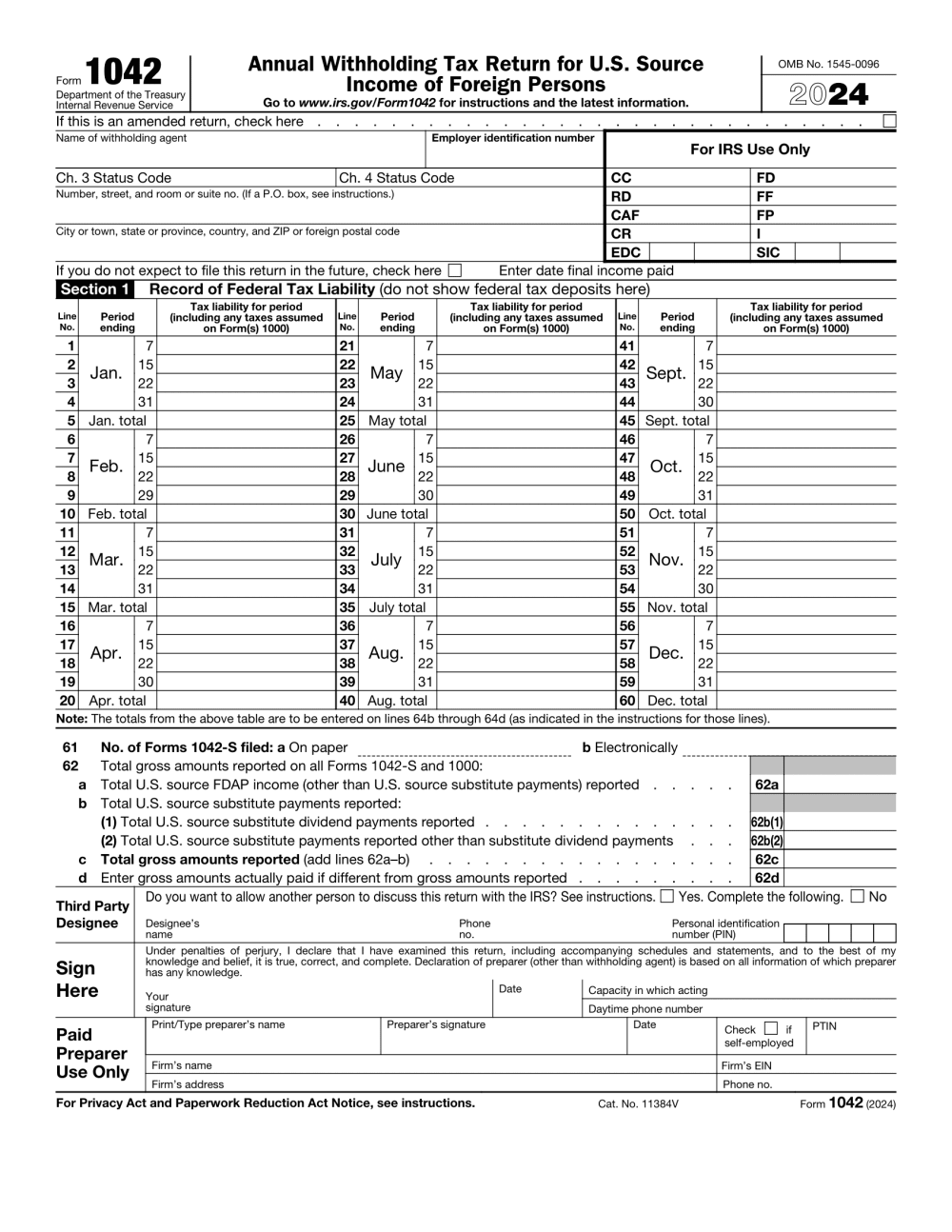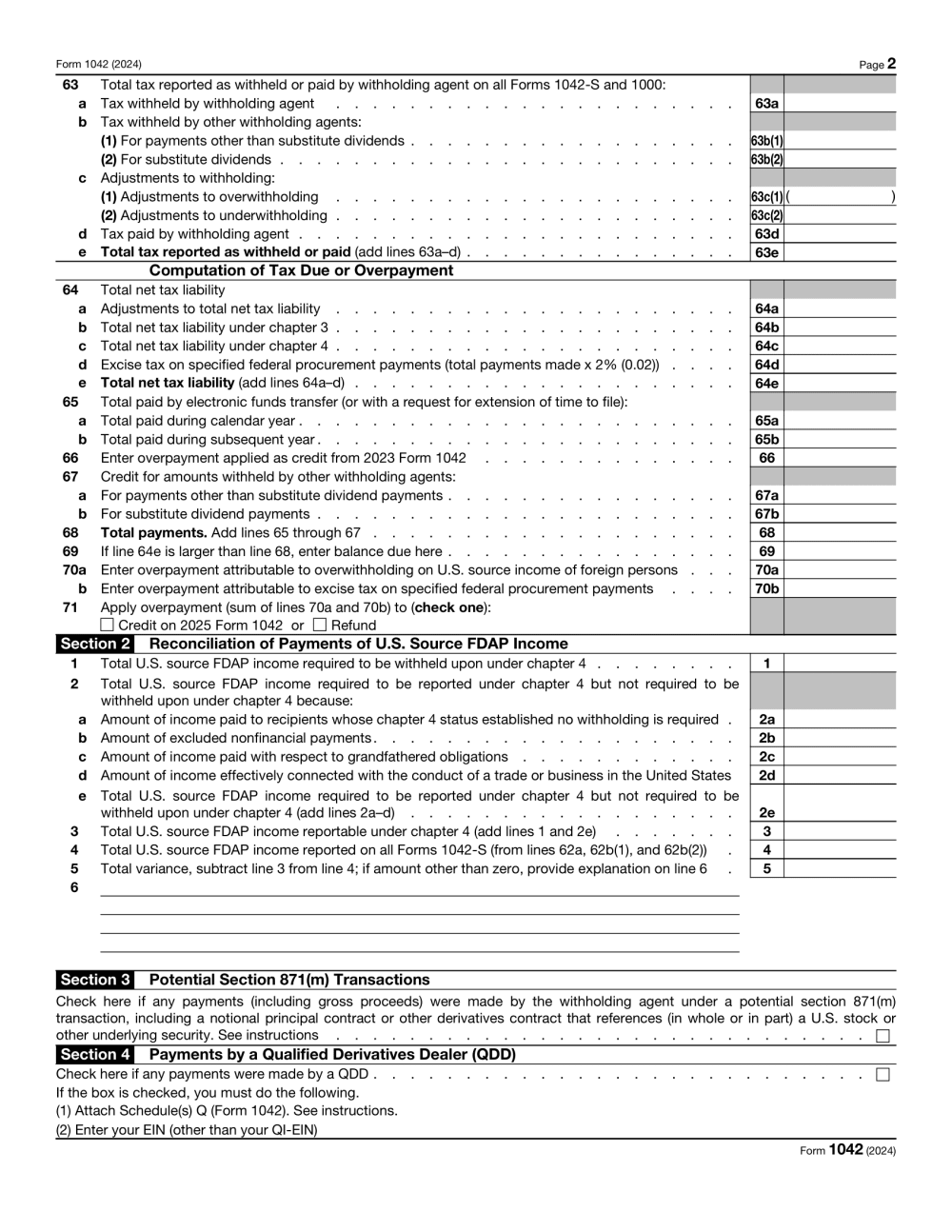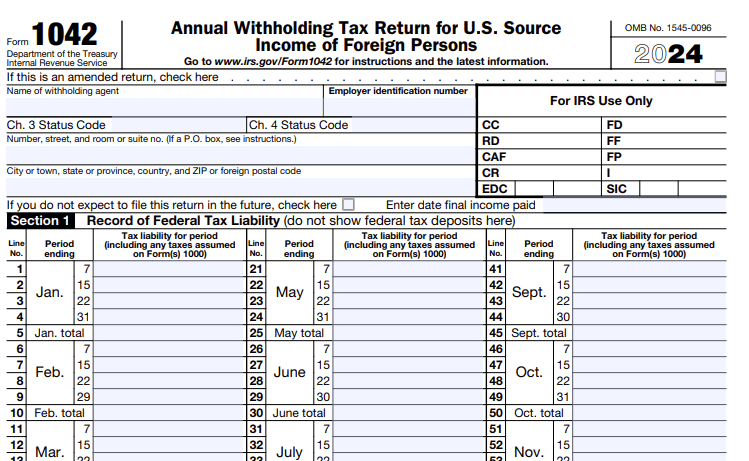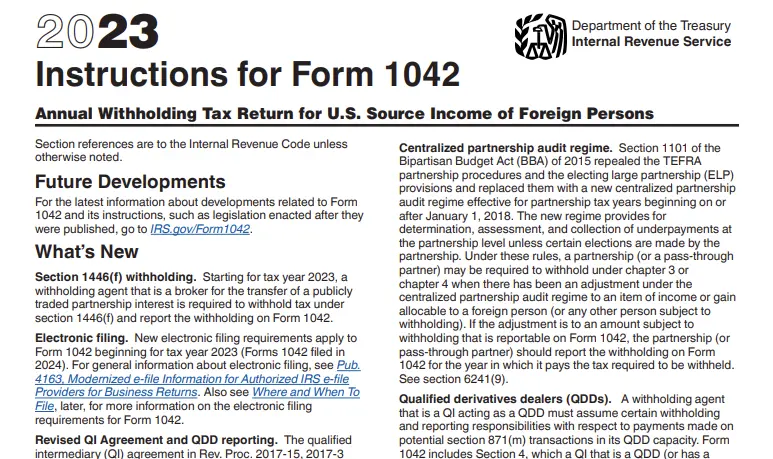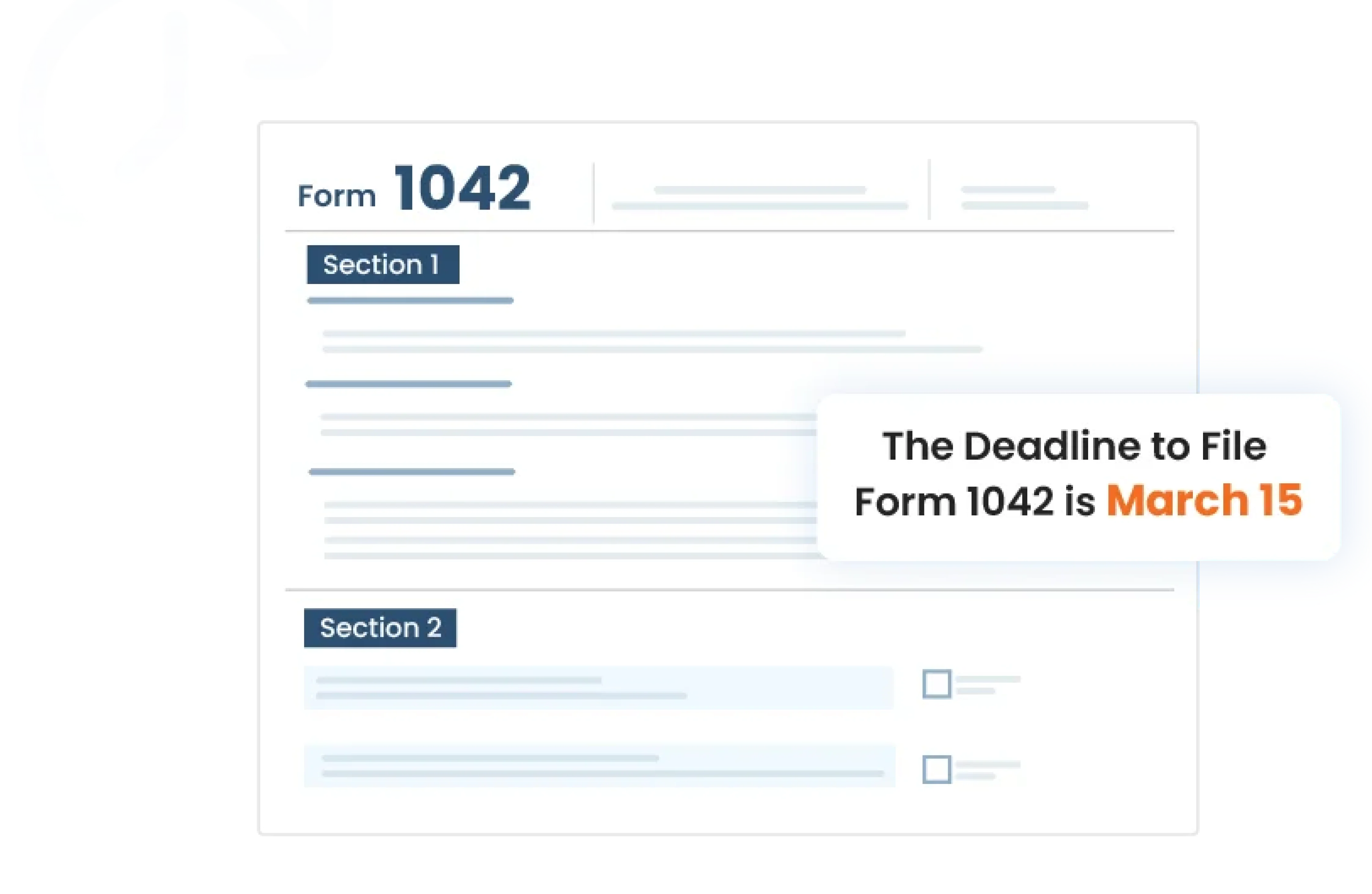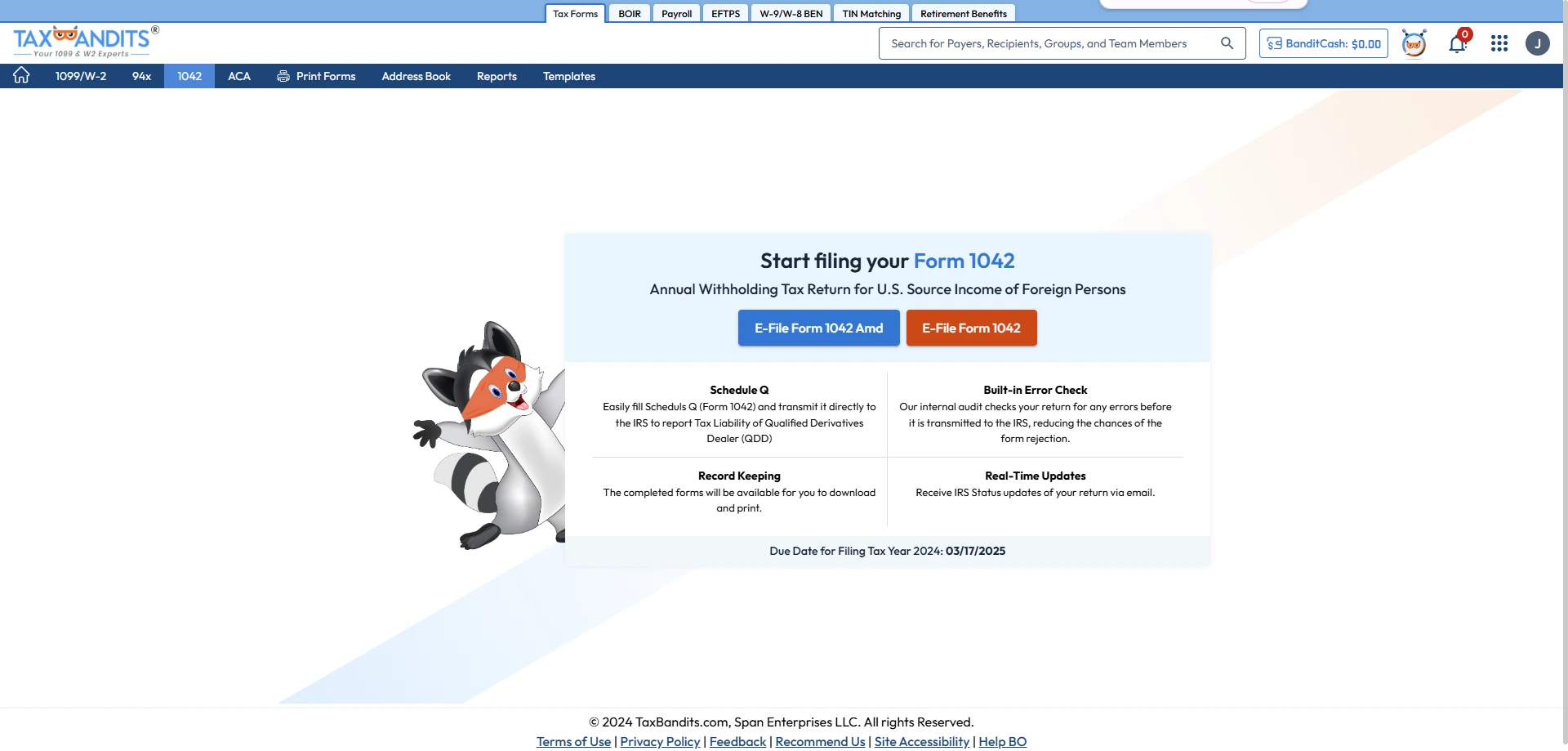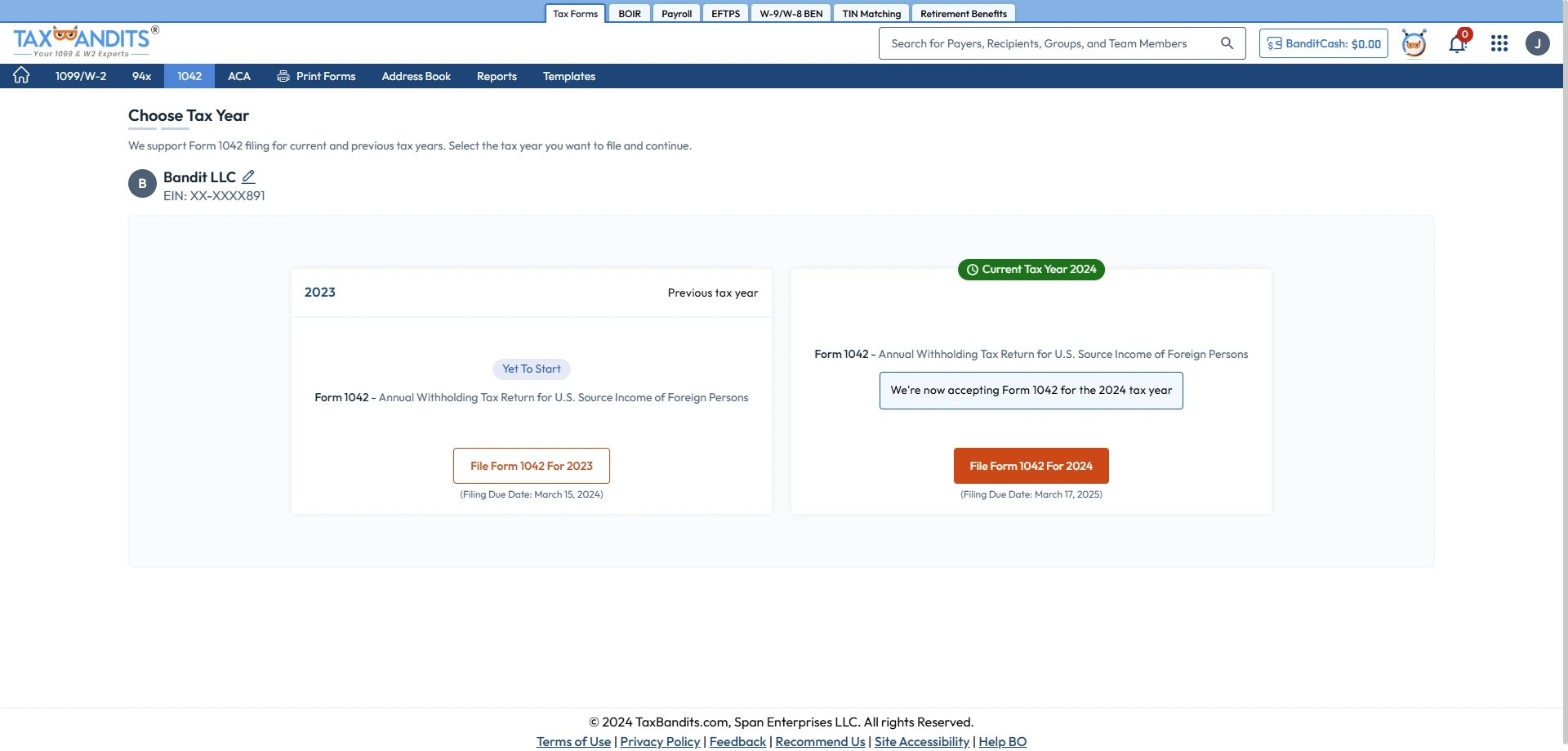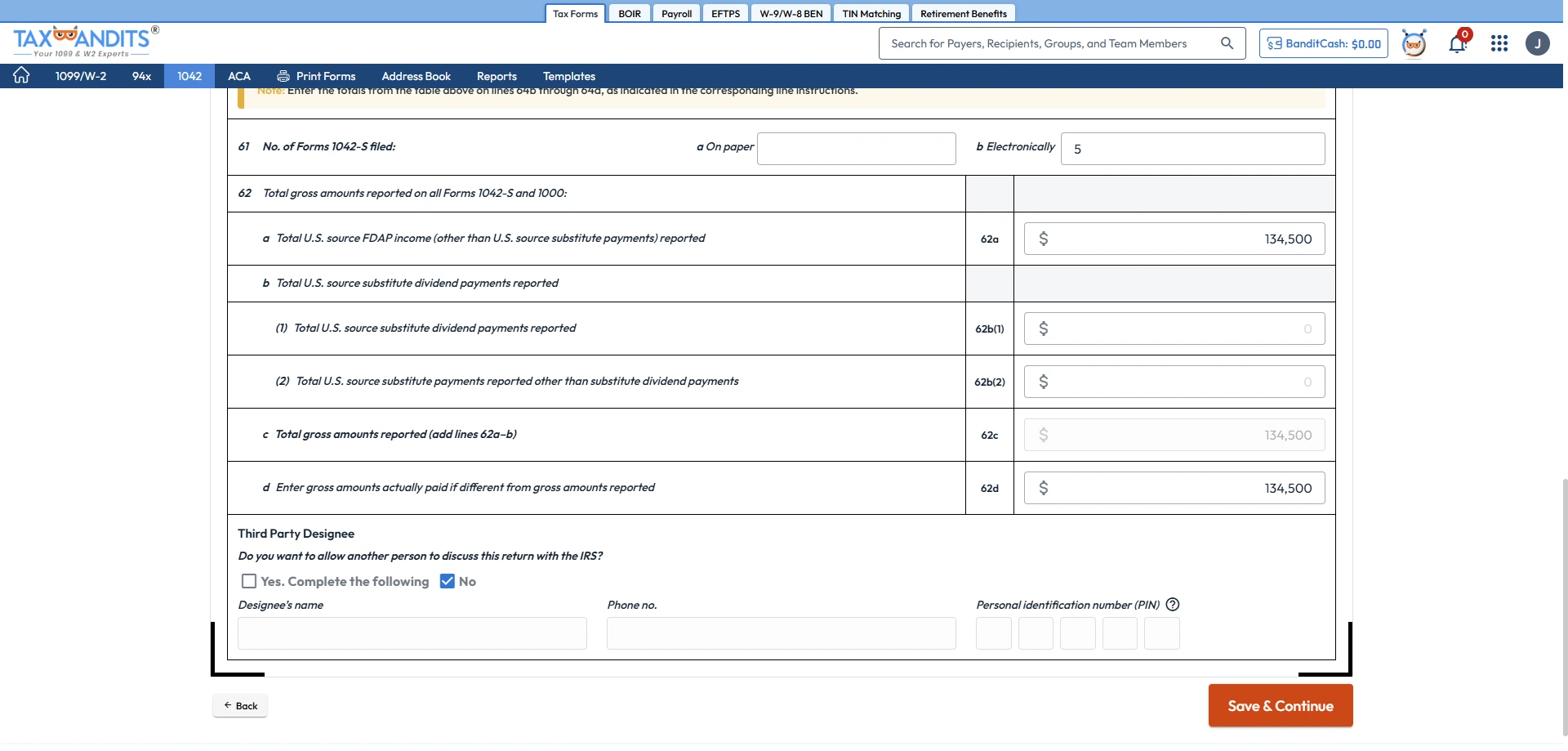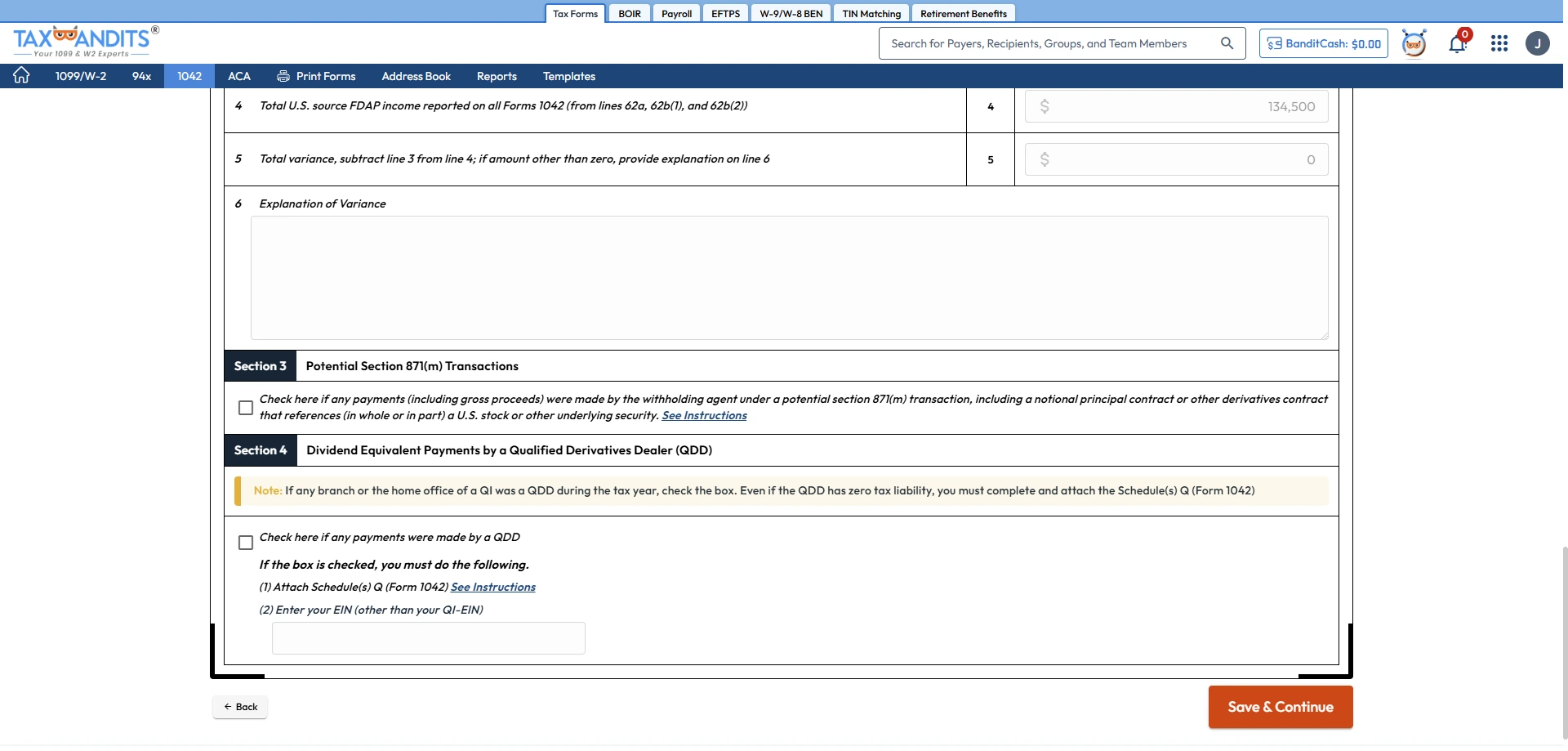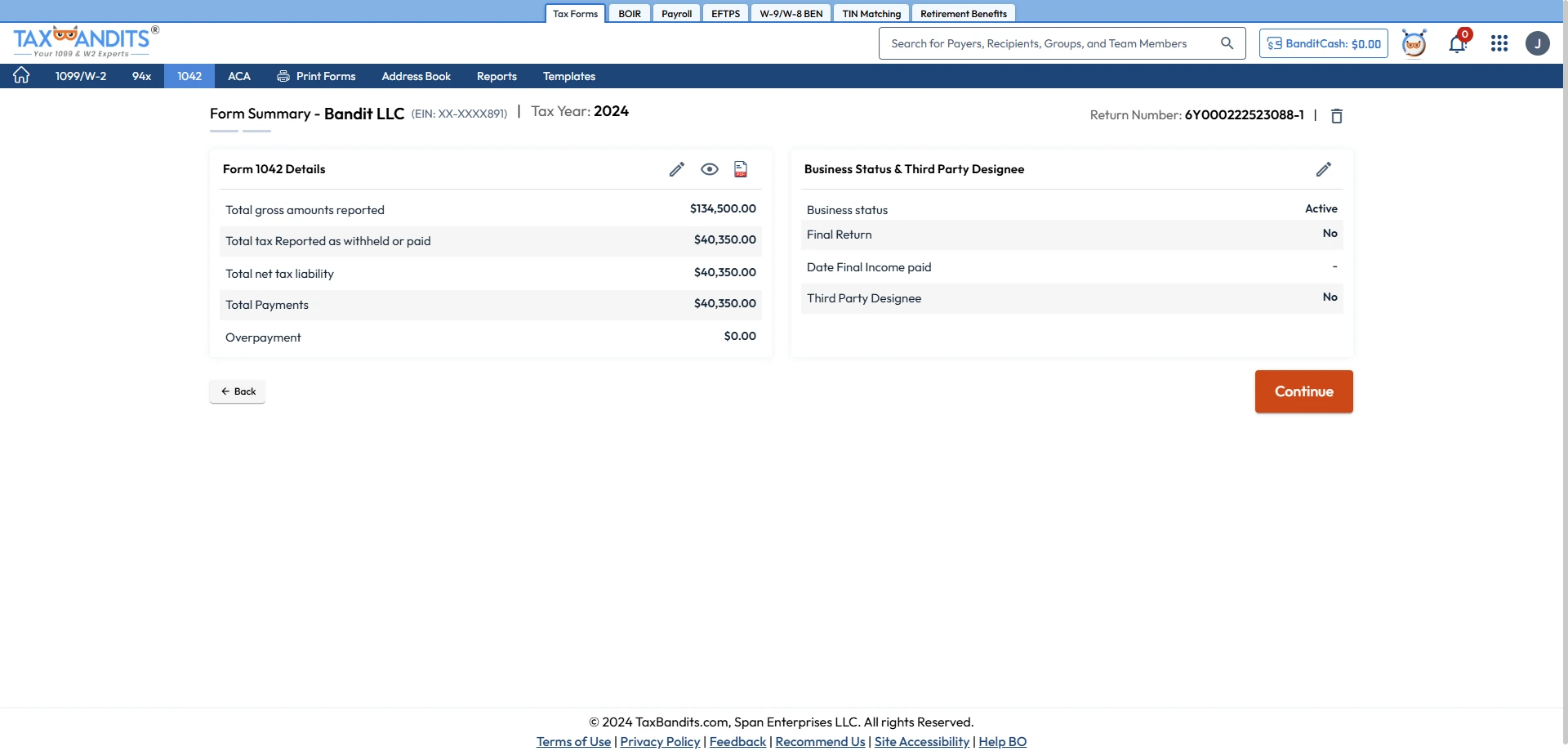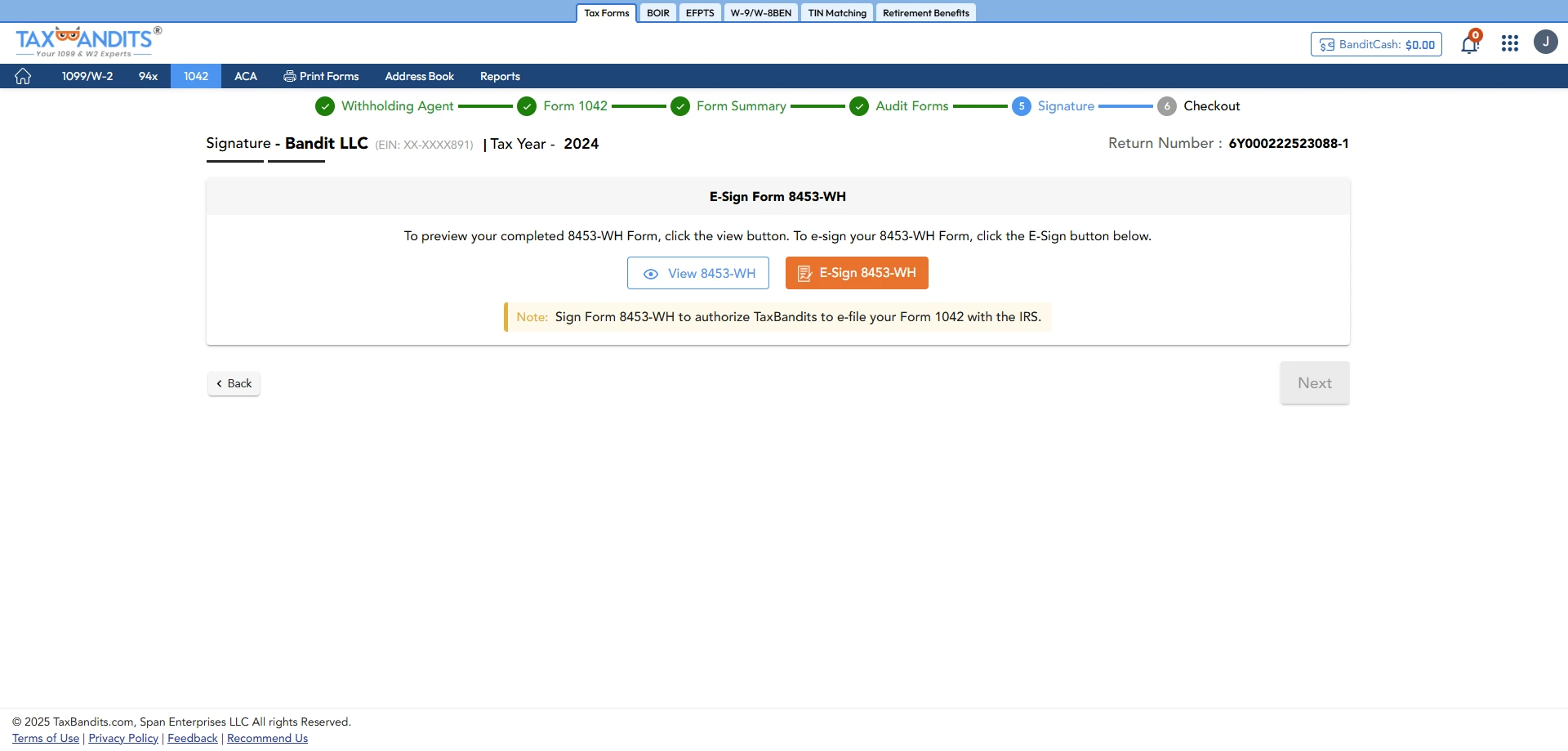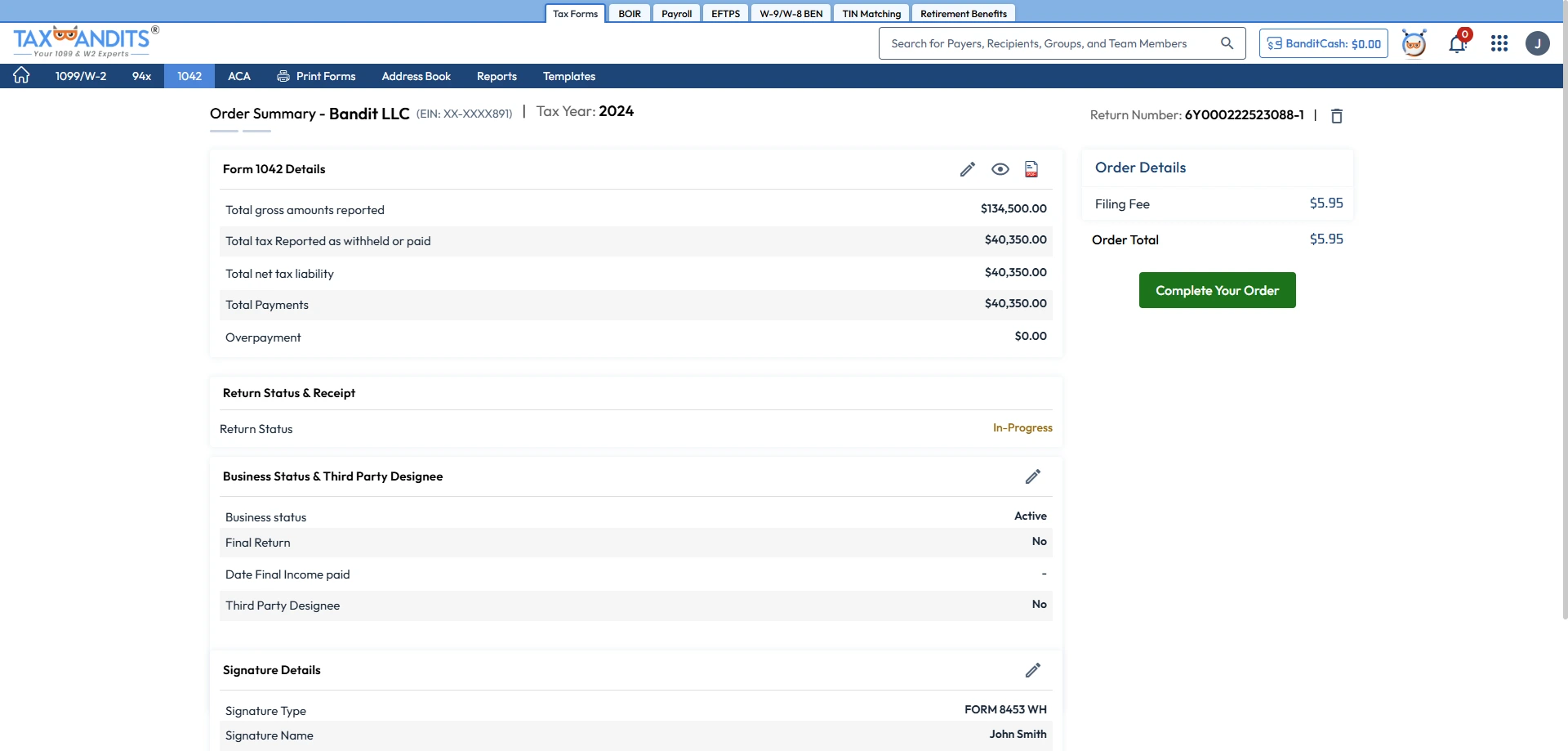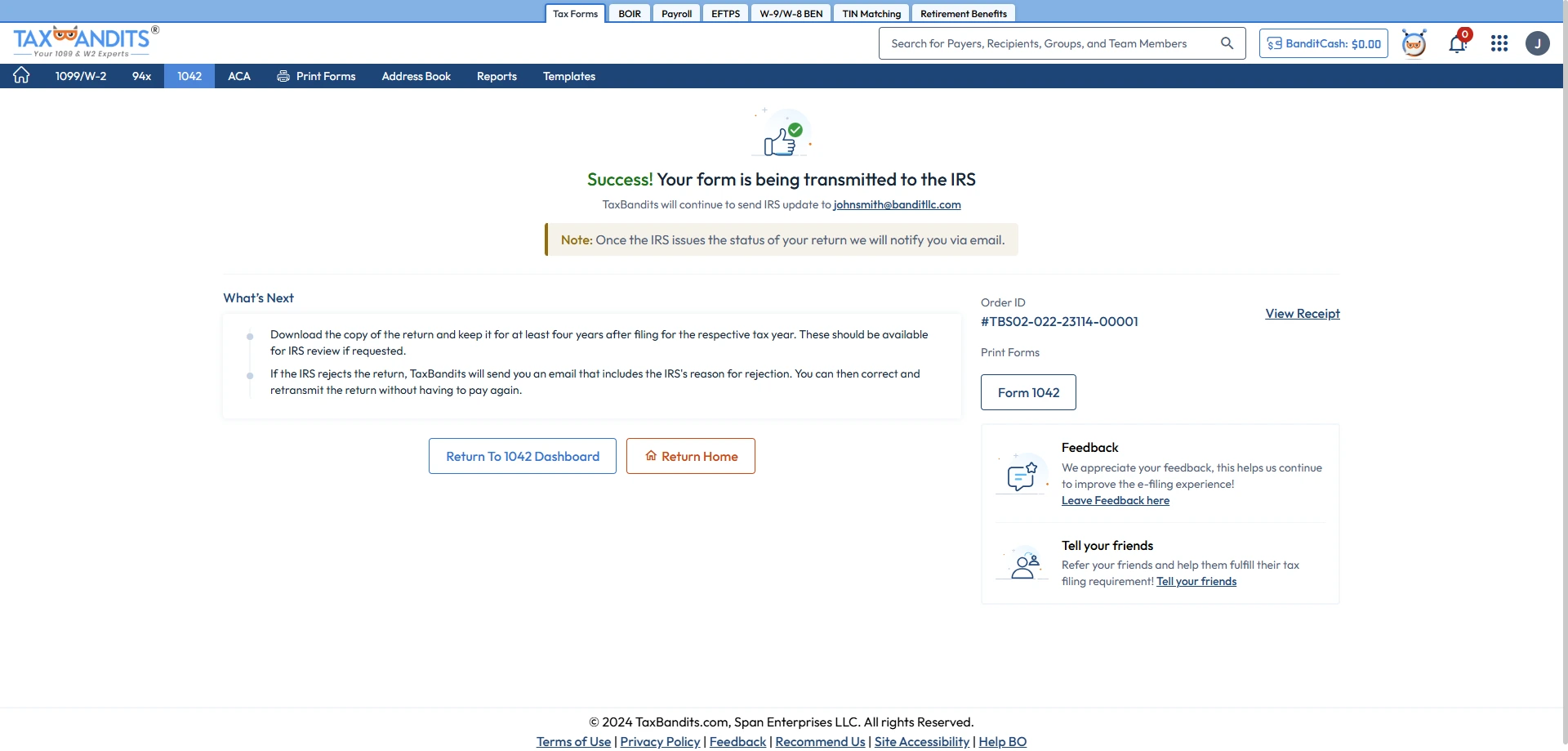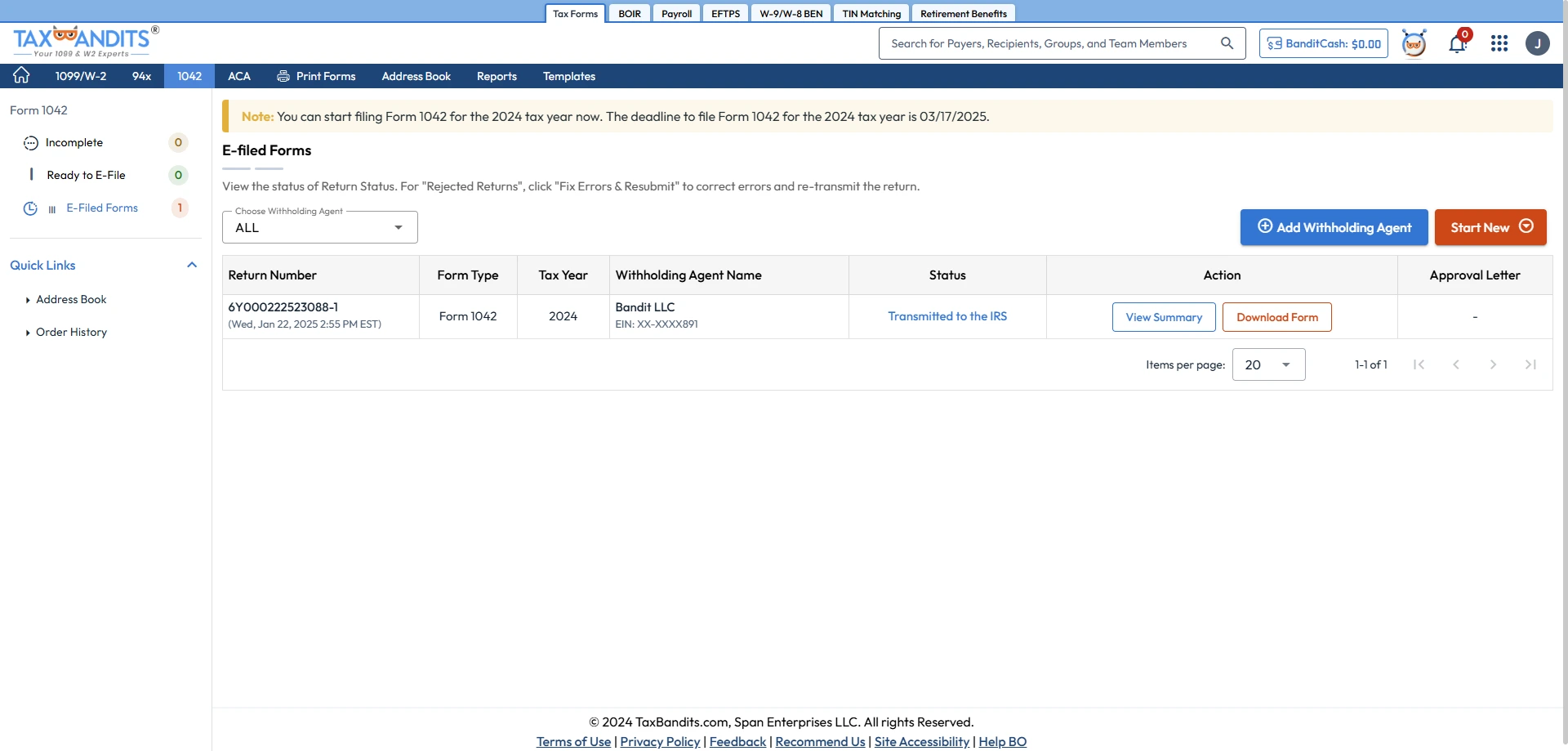Powerful Features That Make Your Form 1042 Filing Easier
Explore why TaxBandits is your go-to platform for fast and accurate filings.
Supports Schedule Q
Qualified Derivatives Dealers (QDD) can include Schedule Q with Form 1042 through TaxBandits at no additional cost.
Supports Prior Year Filing
TaxBandits supports Form 1042 filing for both the current tax year (2024) and the prior tax year (2023).
Easy Signature Options
Sign your Form 1042 electronically with ease using Form 8453-WH or Form 8879-WH, ensuring a smooth and efficient filing process.
Instant IRS Status Updates
Receive instant status updates via email or text notifications once the IRS processes
your 1042.
Option to Request Extension
If you need additional time to file Form 1042, you can request an extension for up to 6 months by filing Form 7004.
Supports 1042 corrections
Made a mistake on a previously filed Form 1042? Easily file corrections electronically through TaxBandits.
Form 1042 electronic filing is made easier with our time-saving features.
Exclusive 1042 Filing Solution Designed for Tax Professionals!
TaxBandits is the ideal platform for managing and streamlining 1042 filings for all your clients in one place.
Upload Client Data in Bulk
Use our CSV Template to upload your client’s tax liability data in bulk, eliminating the hassles of manual entry.
Team Management
Invite your team to manage 1042 filings by assigning roles (preparer, approver, and transmitter) for a more collaborative filing process.
Volume Based Pricing
Maximize savings with our volume-based pricing! Reach out to our support team for personalized pricing solutions.
Form 1042 Electronic Filing Pricing
Easy, accurate, and secure 1042 filing at the industry’s lowest pricing!
- Includes Schedule Q, 8453-WH
- Built-in error checks
- Phone, email & live chat support
- Timely deadline reminders
$5.95 /Form
How to File 1042 Electronically Using TaxBandits?
To file Form 1042 electronically, create a free TaxBandits account and follow these simple steps:
-
Step 1: Select Form 1042
Choose Form 1042 and select the appropriate tax year.
-
Step 2: Enter Form Information
Enter the Withholding agent details, income type, tax withheld, and any applicable exemptions.
-
Step 3: Review and Transmit
Ensure the entered information is correct. Once confirmed, pay and transmit it to the IRS.
Get started with TaxBandits and file Form 1042 online in minutes
Watch how to E-file Form 1042
How to get Extension for
Form 1042 Filing
If you need additional time to file Form 1042 to the IRS, you can request an extension for up to 6 months by filing Form 7004.
How to Correct Previously Filed 1042?
If you need to fix mistakes on your previously filed Form 1042,
file an amended Form 1042 for the same tax year.
Information Required to File Form 1042 Online
Gather the following essential details needed to file Form 1042 online.
-
1. Withholding Agent Information
- Name, EIN, address, Chapter 3 and Chapter 4 status codes
-
2. Record of Federal Tax Liability Information
- Tax liability information for the year
- Number of 1042-S filed electronically or on paper
- Total gross amounts reported on Forms 1042-S and 1099
- Total tax reported as withheld or paid
-
3. Reconciliation of U.S. Source FDAP Income
- Total U.S. Source FDAP Income Paid
- Income Reported on Form 1042-S
- Exemptions or Reductions Due to Tax Treaties
-
4. Potential Section 871 (m) Transactions
- Total Amount of Dividend Equivalent Payments
- Total Withholding Tax on 871(m) Payments
-
5. Payments by a Qualified Derivatives Dealer (QDD)
- Attach Schedule Q (Form 1042)
- Enter EIN other than QI-EIN
Have all the information ready to file 1042 online?
Frequently Asked Questions on 1042 Filing
What is Form 1042?
Form 1042, Annual Withholding Tax Return for U.S. Source Income of Foreign Persons, is used to report withholding on U.S. source income paid to foreign persons, including interest, dividends, and other FDAP income.
Get detailed information about IRS Form 1042.
What’s new in Form 1042 for the 2024 Tax Year?
The following are the changes made by the IRS to Form 1042 for 2024:
Electronic Filing Requirements
Starting from the 2024 tax year, withholding agents, particularly financial institutions and those filing 10 or more information returns annually or partnerships with over 100 partners, are required to file 1042 electronically with the IRS.
Credit Forward Framework
The IRS has announced that the "credit forward framework" described in Notice 2010-46 is being phased out. This framework allowed withholding agents to manage overwithheld taxes in certain financial transactions. Effective January 1, 2025, all withholding agents must cease using this method.

What is the Credit Forward Framework?
The Credit Forward Framework is a tax planning strategy that allows businesses and individuals to carry out unused tax credits to offset future liabilities. This framework helps taxpayers maximize the benefits of tax credits that they may not be able to fully utilize in a given tax year due to income limitations or insufficient tax liability.
Who Must File Form 1042?
Form 1042 is required for entities that withhold tax on U.S. source income paid to foreign persons. This includes:
- U.S. financial institutions and businesses making payments to foreign individuals or entities
- Withholding agents responsible for tax deductions on FDAP income
- Qualified Intermediaries and certain foreign partnerships
For more detailed information on this, click here.
What is Schedule Q (Form 1042)?
Schedule Q (Form 1042) provides detailed information about the tax liability of Qualified Derivatives Dealers (QDD), even if a particular QDD has no tax liability. This schedule is part of the annual reporting requirements for U.S. source income paid to foreign persons and is related to the reporting of withholding taxes.

What’s New?
Schedule Q has been amended to reflect Notice 2024-44, which extends the transition relief for certain provisions of the section 871(m) regulations. This change affects Qualified Derivatives Dealers (QDDs) and their reporting requirements.
What are the Chapter 3 and 4 status codes on Form 1042?
On Form 1042, Chapter 3, and Chapter 4, status codes are used to identify the specific classification of withholding agents and recipients under U.S. tax laws. These codes are important for determining tax withholding and reporting requirements under Chapters 3 and 4 of the Internal Revenue Code (IRC).
- Chapter 3 Status Codes: Chapter 3 governs withholding tax on payments of U.S.-source income made to foreign persons. The status codes identify the recipient type under Chapter 3.
- Chapter 4 Status Codes: Chapter 4 refers to the Foreign Account Tax Compliance Act (FATCA), which aims to prevent U.S. tax evasion by requiring foreign financial institutions (FFIs) and other entities to report U.S.-owned accounts. Status codes under Chapter 4 identify the recipient or withholding agent's FATCA classification.
When is the deadline to file Form 1042?
The Form 1042 due date for the 2024 tax year is March 17, 2025. Missing the deadline or not requesting an extension may result in penalties. To learn more about this, click here.
If you file Form 1042 late or fail to pay or deposit the tax when due, you may be subjected to penalties and interest. Click here to learn the Form 1042 penalties for late filing and payments.
Helpful Videos to File 1042 Electronically
Helpful Resources to File 1042 Online




